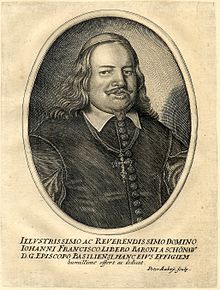Johann Franz von Schönau
Johann Franz von Schönau (born July 15, 1619 in Ensisheim ; † November 30, 1656 in Pruntrut ) was Prince-Bishop of Basel for three years from 1653 .
Life
Johann Franz von Schönau was born in 1619 in Ensisheim, the provincial capital of Upper Austria, as the son of Marx Jakob von Schönau and Margaretha von Reinach. He spent his childhood in Waldshut on the Upper Rhine, where his father took over the office of forest bailiff and mayor governor. As a younger son, Johann Franz was designated for the clergy. After studying Catholic theology in Pruntrut, Freiburg im Breisgau and Lucerne and at the Collegium Germanicum in Rome , Johann Franz von Schönau was appointed cathedral dean of Eichstätt in 1639 . In 1640/1641 he was appointed dean and canon and in 1649 provost of Basel. He was ordained a priest in 1648. Basel introduced the Reformation in 1529 . The Catholic cult was banned. The Prince-Bishop Wilhelm Rink von Baldenstein moved the official seat of the Prince-Bishop to Pruntrut as early as 1527, while the cathedral chapter found its exile in the Catholic Freiburg im Breisgau before moving to Arlesheim below Birseck Castle in 1679 . Johann Franz von Schönau therefore performed his offices in Freiburg im Breisgau. In 1651 he was elected Prince-Bishop of Basel. As one of the first official acts after the episcopal ordination in 1653, Johann Franz von Schönau relocated the residence of the Basel prince-bishops back to Pruntrut. In 1654 he reactivated the iron mining, which had fallen through the Thirty Years' War, by founding a foundry in Reuchenette . In terms of defense policy, he sought proximity to the seven Catholic towns of the Swiss Confederation with which he concluded an alliance in mid-1655 that was directed against France. Johann Franz von Schönau, who was about to be elevated to the rank of cardinal, died in Pruntrut in 1656 after a short period of office, where his body was buried in the Jesuit church. The heart was buried in a lead capsule in the will in the Capuchin Church in Waldshut . The epitaph there and the heart capsule were transferred to the nearby Gottesackerkapelle in 1825.
Individual evidence
- ^ Johann Melchior Schuler : The deeds and customs of the old confederates , Volume 3 , Schultheß, Zurich, 1844, p. 628.
- ^ Mariano Delgado, Markus Ries (eds.): Karl Borromäus and the Catholic Reform: Files of the Freiburg Symposium, Academic Press Friborg, Kohlhammer Stuttgart, 2010, p. 314
- ^ Johann Huber: History of the Zurzach Monastery: A contribution to Swiss church history [1]
- ^ Argovia, Volume 4, born in 1864 and 1865, Historical Society of the Canton of Aargau, Sauerländer, Aarau, 1866, footnote p. 35.
literature
- Catherine Bosshart-Pfluger: Johann Franz von Schönau, Prince-Bishop of Basel. In: Werner von Schönau-Wehr, Katharina Frings (Hrsg.): Aristocracy on Upper and Upper Rhine. On the history of the barons of Schönau. Rombach, Freiburg i. Br. 2001, ISBN 3-7930-9282-8 , pp. 283-300.
Web links
- Catherine Bosshart-Pfluger: Schönau, Johann Franz von. In: Historical Lexicon of Switzerland .
- Pruntrut Castle
- Johann Franz von Schönau (PDF; 1.1 MB)
| predecessor | Office | successor |
|---|---|---|
| Beatus Albrecht von Ramstein |
Bishop of Basel 1653–1656 |
Johann Konrad I. von Roggenbach |
| personal data | |
|---|---|
| SURNAME | Schönau, Johann Franz von |
| ALTERNATIVE NAMES | Schönau-Zell, Johann Franz von |
| BRIEF DESCRIPTION | Prince-Bishop of Basel |
| DATE OF BIRTH | July 15, 1619 |
| PLACE OF BIRTH | Ensisheim |
| DATE OF DEATH | November 30, 1656 |
| Place of death | Pruntrut |


